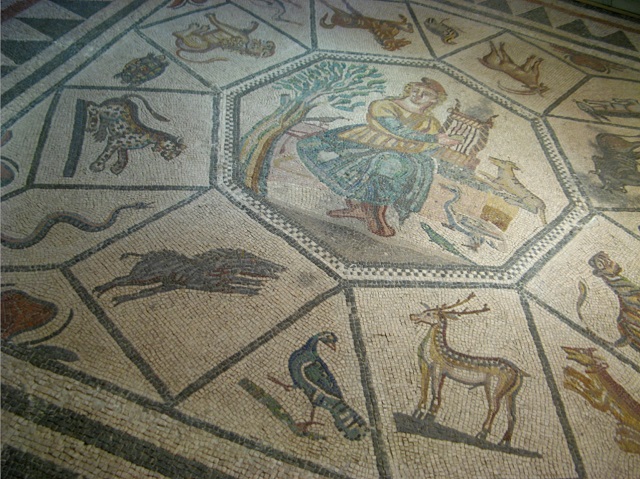July 16 – 25, 2016 —
Two days of cooperative winds gave us a perfect opportunity to sail north. The meltimi winds seem to be blowing back to back this summer so we are taking advantage of any breaks in the northerlies to get further north. On Saturday the winds were light from the south so we left Patmos with the rising sun and sailed nearly 65 miles north to the island of Khios. Our arrival at the marina in Khios was after sunset but we managed to get the last side-to slip on the quay. It was a good ending to a good day.
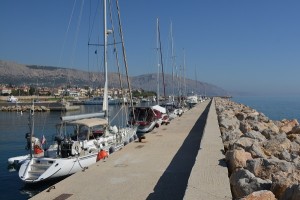 What was to be Khios Marina, on the east coast of the island, is suffering the same blight of many other marinas in Greece, likely for the same reason. The EU provided funds to Greece to build marinas to help tourism. In many areas, the marinas were started. The money either ran out or disappeared, no one really knows, and all construction stopped leaving an unfinished marina. Khios has an excellent protective sea wall for the marina, the slips are in and a spot for a travel lift built. That is it. The docks are unfinished and there is no electrical power or water. There is not even a finished road connecting the marina to the main street in front of it. It has been all but abandoned and it is deteriorating rapidly without maintenance. It is all very sad to see what could have been and even sadder to see the same thing repeated over and over throughout Greece. For us, the positive side of all of this is that the marina is free–small consolation, we would rather see it fresh and prosperous. That said, the marina was a good place to stop when passing through, and the price is right!
What was to be Khios Marina, on the east coast of the island, is suffering the same blight of many other marinas in Greece, likely for the same reason. The EU provided funds to Greece to build marinas to help tourism. In many areas, the marinas were started. The money either ran out or disappeared, no one really knows, and all construction stopped leaving an unfinished marina. Khios has an excellent protective sea wall for the marina, the slips are in and a spot for a travel lift built. That is it. The docks are unfinished and there is no electrical power or water. There is not even a finished road connecting the marina to the main street in front of it. It has been all but abandoned and it is deteriorating rapidly without maintenance. It is all very sad to see what could have been and even sadder to see the same thing repeated over and over throughout Greece. For us, the positive side of all of this is that the marina is free–small consolation, we would rather see it fresh and prosperous. That said, the marina was a good place to stop when passing through, and the price is right!
Defunct Marina off Khios: 38˚ 23.11’ N, 026˚ 08.57’ E (outside entrance). Keep within 50 feet of quay upon entering. There is a green navigation light on the southern end of the quay that currently is operational. No services, water or electric.
Khios was just an overnight stop for us as we had one more day of east winds that would help us get further north to Lesvos. It looks like Lesvos will be our most northern point this season.
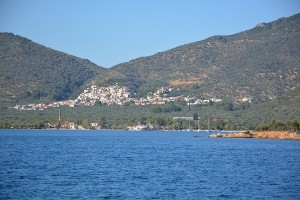
With the winds from the east we had a wonderful sail on to Lesvos, aware that the next meltimi was due two days later. 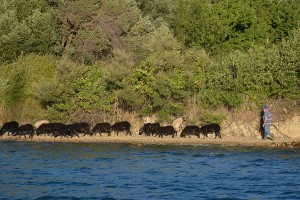 Lesvos, the third largest island in Greece, has two large bays on the southern part of the island that provide good protection in high wind and seas. We headed into the smaller of the bays, Kolpos Yeras, and motored a few miles north to Skala Loutra, a small harbor with fishing and boat service industries. We anchored out in a remote spot with just two other boats in sight, with the only action on shore a herd of goats and their herder passing by morning and evening. The closest town is a 30 minute walk up hill with nothing much else around it, so we decided that in spite of the good anchorage, we did not want to get stuck there for a week in the high winds.
Lesvos, the third largest island in Greece, has two large bays on the southern part of the island that provide good protection in high wind and seas. We headed into the smaller of the bays, Kolpos Yeras, and motored a few miles north to Skala Loutra, a small harbor with fishing and boat service industries. We anchored out in a remote spot with just two other boats in sight, with the only action on shore a herd of goats and their herder passing by morning and evening. The closest town is a 30 minute walk up hill with nothing much else around it, so we decided that in spite of the good anchorage, we did not want to get stuck there for a week in the high winds.
Kolpos Yeras anchorage: 39˚ 02.35’ N, 026˚ 31.59’ E. Great protection from all points except north-west which will get fetch from across three to four miles of open bay. Excellent holding in heavy sand.
After the one night we motored around to the marina in Mitilini, the capital of Lesvos. That evening we went to the tavern in the marina for a late dinner. As we were discussing the town and putting together a plan for the week, the man at the next table turned and asked, in perfect English, if we needed any information. He asked where we were from. Within a minute we found that we lived three miles apart in the US–we were in Andover, they are in North Andover! It certainly is a small world. They are Mike and Cathy. Cathy even graduated from Andover High School. Mike is Greek, raised on Lesvos. They now also have a home here where they spend summers. The day we were leaving Mike and Cathy arrived at our boat with a bottle of local ouzo from the village Mike grew up in. It was very nice.
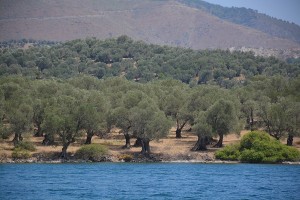 Lesvos, pronounced “Lesbos” and commonly spelled “Lesbos”, is known for two main products – olives (olive oil) and ouzo. There are eleven million olive trees on the island and the olive oil produced from them is considered some of the best in Greece. Half of the ouzo produced in the world comes from this island where the anise plants are grown and the liqueur recipe is kept secret. We did see ouzo consumed everywhere, often with mezzes, the local term for appetizers.
Lesvos, pronounced “Lesbos” and commonly spelled “Lesbos”, is known for two main products – olives (olive oil) and ouzo. There are eleven million olive trees on the island and the olive oil produced from them is considered some of the best in Greece. Half of the ouzo produced in the world comes from this island where the anise plants are grown and the liqueur recipe is kept secret. We did see ouzo consumed everywhere, often with mezzes, the local term for appetizers.
Legend has it that the poetess Sappho, who was born on Lesvos in 612 BC, is one of ancient Greece’s most outstanding poets. Her sensual poems and preference for her own sex led to the term “lesbian”–taken from the name of the island.
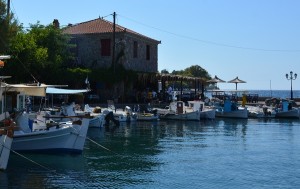 We took two days to tour the island including the fabulous towns of Skala Sikamineas and Molivos. We stayed at a lovely small B&B right on the harbor in Molivos.
We took two days to tour the island including the fabulous towns of Skala Sikamineas and Molivos. We stayed at a lovely small B&B right on the harbor in Molivos.
B&B: Sea House Hotel, 60 Euro per night, great views and nice breakfast served outside on the shaded quay
Molivos is a town of stone buildings and narrow cobble stone streets with a delightful and active harbor of fishing boats. The restaurants and cafes were wonderful. Of course every menu has fresh fish and ouzo. The shortest route to Molivos for the last ten miles was a dirt and gravel road that winded its way along the coast with no guard rail and often at impressive heights from the sea below. 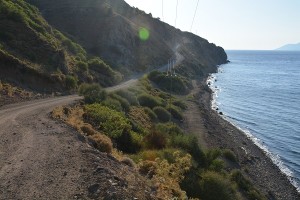 One wrong skid and we would have been goners!
One wrong skid and we would have been goners!
Like Kos, what has dominated Lesvos in the news for the last year is the migrant flow to the island from Turkey. Most arrivals are on the north coast of Lesvos, where the journey is four miles from Turkey to Greece.
A positive part of the story is that the residents of Lesvos were nominated for a Nobel Peace Prize for their humanitarian work with the arriving migrants. Last summer volunteers from the island met boats arriving on a daily basis to help people. The walk from the landing beaches to the area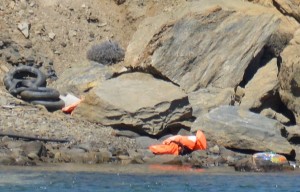
where migrants are processed and housed is a 60 kilometer walk over high hills in the blazing heat. 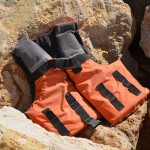 The island responded by sending buses to the north shore to provide free transportation to the new arrivals. We had heard about the mountains of life jackets abandoned on the beaches. We did not see the piles of life jackets but did see lots of them washed up on the shoreline and tangled in trees.
The island responded by sending buses to the north shore to provide free transportation to the new arrivals. We had heard about the mountains of life jackets abandoned on the beaches. We did not see the piles of life jackets but did see lots of them washed up on the shoreline and tangled in trees.
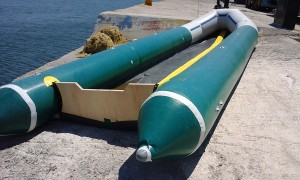 Abandoned dinghies that were used to transport the migrant groups are piled in several areas. We were shocked at how poorly constructed they are. They were basically homemade for a one time use. They are long and narrow, segments of inflated tubes cemented together, with just a raw piece of plywood for the transom. In these “boats” four miles is a very long journey, especially if the seas are rough.
Abandoned dinghies that were used to transport the migrant groups are piled in several areas. We were shocked at how poorly constructed they are. They were basically homemade for a one time use. They are long and narrow, segments of inflated tubes cemented together, with just a raw piece of plywood for the transom. In these “boats” four miles is a very long journey, especially if the seas are rough.
We hear less of the migrant flow this summer and the numbers are certainly down, but far from stopped. The day before we left Lesvos 700 migrants arrived on the island in one day. 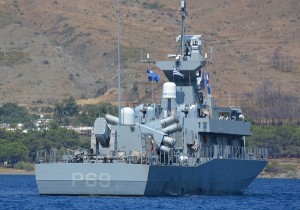 Enough groups are still arriving that other EU countries have a presence and are helping out. There are border patrol boats from Italy, Norway and Britain, along with a large NATO ship patrolling the waters around Lesvos. There is a strong military presence. All of the islands bordering Turkey have patrol boats.
Enough groups are still arriving that other EU countries have a presence and are helping out. There are border patrol boats from Italy, Norway and Britain, along with a large NATO ship patrolling the waters around Lesvos. There is a strong military presence. All of the islands bordering Turkey have patrol boats.
On Sunday we visited the Mytilene Archaeological Museum which showcases pottery and mosaic tile work from the 1st and 2nd centuries AD during the Roman Period. The museum was the finest presentation of antiquities we have experienced throughout the Mediterranean. The display of the early Roman architectural elements within a re-creation of the original structures was remarkable. This is a not to miss museum.
We have been here over a week and the meltimi is fading—time to move on. We leave Monday morning to go back south, taking our time to explore new islands and anchorages before getting back to Kos.

